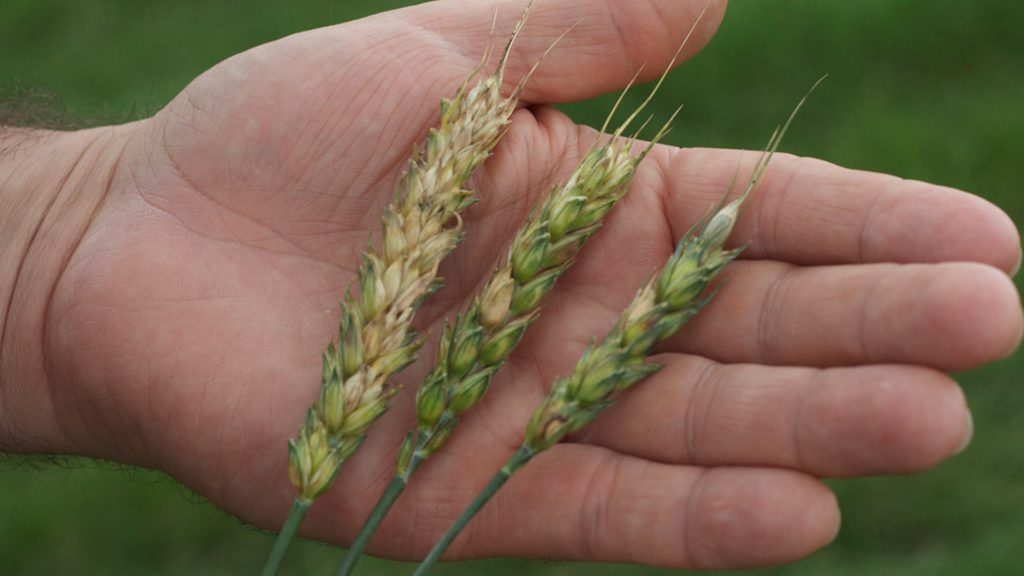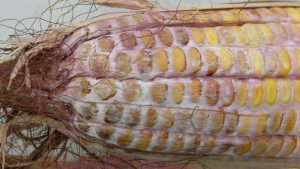The organic angle
NEW RESEARCH COULD BENEFIT ALL GROWERS

ALL ONTARIO GRAIN farmers could benefit from organic agriculture research projects currently being conducted around using probiotics to combat disease, new soybean cultivars and year-round crop rotations.
Grain Farmers of Ontario is partnering on the projects as part of the Organic Science Cluster 3 (OSC3) initiative, which is administered by the Organic Federation of Canada in collaboration with the Organic Agriculture Centre of Canada at Dalhousie University. OSC3 is supported by more than $8.3 million from the Canadian Agricultural Partnership, a federal-provincial-territorial investment. More than 70 other agricultural organizations are involved.
BATTLING FUSARIUM HEAD BLIGHT
Dr. Manish Raizada, a professor in the Plant Agriculture Department at the University of Guelph is working on developing a spray that could fight Fusarium head blight (FHB), a stubbornly pervasive disease in small grains like corn and wheat.
Raizada started his research in response to growers’ concerns with the toxins produced by FHB that threaten the human and livestock food chains and damage profitability. He says that the effects of climate change — with an increased probability of humid and wet weather — make the perfect conditions for FHB to thrive.
Current control strategies include fungicides, which are only somewhat effective and cannot be used by organic producers, and breeding new varieties.
“It’s an arms race in terms of speed of the evolution of the pathogen and the breeding strategies,” he says. “Creating a real-time, in-season solution using an equally evolvable probiotic would help both organic and conventional grain farmers.”
He was also inspired by the growing knowledge around the ability of the natural microbiome in plants to combat the pathogens.
“Ultimately our goal is to develop a probiotic bacteria spray for crops,” he says, noting while fungicides can kill off fungus, they can’t kill bacteria, so the technology could also be used by conventional farmers.
FHB is transmitted through spores in the air that enter the flower head of the plant and travel into the stem (rachis). Raizada’s theory is that there are beneficial bacteria (endophytes) in the vascular tissue of the plant’s rachis that could combat the disease.
He has piggy-backed on the work of his colleague, the late associate professor Ali Navabi at the University of Guelph. Navabi and his team had profiled about 300 different varieties of wheat — going back to the late 1800s — for resistance to FHB. Out of these, they chose a historical panel of 15 varieties.
The collaborative work continues, with Raizada’s team, including graduate student Jade Muileboom, with the hope that they can add new tools to the plant breeder’s toolkit by identifying DNA sequences of certain microbes that exhibit FHB resistance as well.
“Using both the plant and microbe genetic sequences, we can have more robust selections for breeding,” Raizada says.
In addition to the historical Canadian varieties, they’re looking for microbes in five wild plants from the Middle and Near East.
Between the two types, his team has isolated and purified 400 bacterial strains. At the time of writing, Muileboom was testing them in Petri dishes to determine their ability to kill FHB.
By February 2020, they’ll be ready to go to greenhouse trials and field trials. Parallel testing is being conducted into making sure the probiotic bacteria are safe for use in the field.
Raizada’s work in corn has already yielded five bacteria that have done quite well in combatting DON mycotoxin (vomitoxin) in both corn and wheat.
“We’ve found that they can reduce the incidence of the disease by about 60 per cent in greenhouse trials,” he says.
Raizada says that microbes can produce other benefits besides Fusarium resistance — including drought tolerance, nitrogen uptake, root growth and resistance to other pathogens and insects.
Dr. Myriam Fernandez is also working on this project, determining the best organic production practices to suppress FHB and DON mycotoxin in cereal crops. She specializes in organic agriculture and works for Agriculture and Agri-Food Canada in its Swift Current, Saskatchewan facility.
ORGANIC SOYBEAN BREEDING STRATEGIES
Dr. Istvan Rajcan, a professor in the Plant Agriculture Department at the University of Guelph, is developing new soybean cultivars that perform better in organic production systems.
It’s ground-breaking research — a first in Canada and an area that only a very few others around the world have taken on.
It all started with one of Rajcan’s students — Torin Boyle — who was working on his master’s thesis. Boyle recognized that organic producers were using cultivars that had only been researched and had data from non-organic fields. His hypothesis was that cultivars would behave differently under the two different production systems, and that better soybeans could be developed for organic conditions.
In the first experiment, 30 cultivars developed exclusively under the conventional system were grown under organic and conventional conditions for a comparison. The results showed that cultivars that in many cases performed poorly in conventional conditions did well organically and vice versa.
Rajcan, along with colleague Professor Emeritus Ralph Martin, took up the cause and continued the work after Boyle completed his thesis and moved on. They then set about breeding the cultivars right on the organic farms.
“It’s really tough for farmers to grow soybeans organically — they can’t use chemicals or inorganic fertilizers — and I wanted to help those trying to serve a growing market,” Rajcan says, adding that there are currently only about 150 organic soybean growers of the 28,000 grain growers in Ontario.
While their numbers may be low, the payoff is in the price — organic soybeans typically command two to three times the price per bushel of conventional soybeans.
In plant breeding, it normally takes up to 10 generations — from an initial hybrid — to produce a cultivar for commercial release. Rajcan’s team took cultivars from as early as the fifth generation (F5) and started growing them organically, concurrently selecting the best genotypes on both organic and conventional farms. They found that, one-third of the time, the same types were selected and two-thirds of the time, they were different.
“Our results show that setting up a breeding program for organic farmers using organic production methods as the selection tool would improve our ability to develop cultivars that would perform the best,” he says.
In the current project, Ph.D. student Mr. Xin Lu is working with Rajcan to continue breeding the organic cultivars through the next generations to find out how they perform on organic farms in more locations and years.
In Ontario, there are three organic and three conventional field locations where two breeding populations at the F7 generation were grown along with 50 cultivars. At the same time, Dr. Martin Entz of the University of Manitoba is growing 39 cultivars in organic production systems there.
“The data will be stronger in terms of finding out how the plants react to environmental stimuli that are used by different production systems,” Rajcan says. “We hope to have a much better understanding of why soybeans perform better in one production system versus another and why organic farmers might need a separate breeding program.”
Rajcan says there is interest in the project from researchers in the U.S. and Europe. He expects that more will be generated from around the world as they publish more data and the demand for organic products grows.
YEAR-ROUND ORGANIC CROP ROTATION
Dr. Xueming Yang is working on incorporating winter-hardy legume cover crops in an organic soybean-wheat-corn rotation for southern Ontario. The idea is to include two seasons of the legumes and three seasons of the main crops over three years — basically having crops of one kind or another in the ground all year round. The goal is to build up nitrogen and carbon reserves to boost fertility, improve soil health and better protect the environment.
“We are looking at management practices to prevent nitrogen from leaching into the water — which is a serious problem, especially for sandy soil,” says the soil scientist who works at Agriculture and Agri-Food Canada’s Harrow Research and Development Centre. Yang is working with Dr. Craig Drury and Dr. Dan Reynolds on the project.
He explains that, while winter wheat is a popular crop in rotation with soybeans and corn, harvest happens in July or August and the land is often left bare from then to the following crop, normally corn, the next year. During that time, most plant available nitrogen in the soil is lost to leaching. The theory is that seeding winter-hardy cover crops like legumes after winter wheat would help fix the nitrogen and reduce losses.
While some organic farmers use manure to boost fertility, some choose not to because it may not be readily available or they want to avoid overapplying phosphorus.
Yang says there are multiple benefits to using any kind of cover crop, including reducing soil erosion, controlling weeds, increasing the biodiversity of the soil and building up organic matter over the long term.
In this experiment, he’s comparing how well summer-seeded crimson clover, hairy vetch and red clover perform as cover crops. Two phases are included in the rotation — one planted after the winter wheat harvest grows through to the next spring and is plowed down for corn planting and the other is inter-seeded into standing corn, grows through to the next spring and then is incorporated for soybean planting.
“Corn yields typically will be reduced significantly if crop nitrogen needs cannot be met,” Yang says. During this research, the use of legume cover crops doubled corn yield compared to fields without cover crops and chemical fertilizers.
The researchers are measuring cover crop biomass and nitrogen content as well as sampling the soil for nitrogen, organic carbon, phosphorus, pH and several other basic soil fertility factors.
“We’ve found that hairy vetch is really good for nitrogen fixing,” he says, adding it’s also easier to establish, manage, and kill before planting. He says that any farmer looking to increase nitrogen reserves for their crops — whether organic or non-organic — could try this rotation.
The cover crop involved in the rotation fields were established in 2014, have passed the conventional to organic transition period and are certified as organic by Pro-CertM. The study will continue to 2023, which will mean one more full rotation to obtain more complete results.
This research project received funding from Grain Farmers of Ontario. •

























